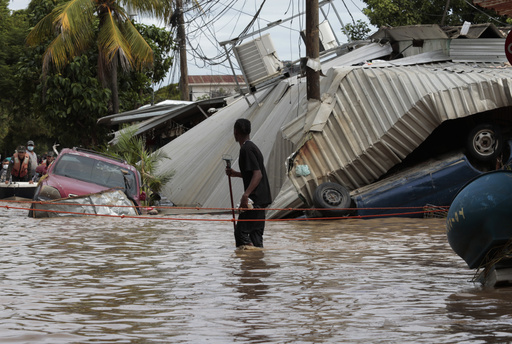
SAVANNAH, Ga. — Tropical Storm Sara has emerged as the third named storm in November, highlighting that the Atlantic hurricane season remains active. The storm developed in the western Caribbean Sea and made landfall on Honduras’ northern coast on Thursday, bringing heavy rainfall as it slowly traverses Central America over the weekend. The National Hurricane Center in Miami reported that some areas could see as much as 40 inches (101.6 centimeters) of rain. As the storm continues, it is anticipated to move over Belize on Sunday before dissipating over the Yucatan Peninsula early Monday.
This month already experienced the impact of two other named storms. Tropical Storm Patty drenched the Azores but ultimately dissipated without making landfall. In contrast, Hurricane Rafael struck Jamaica and the Cayman Islands before moving across Cuba as a Category 3 storm. November has thus shaped up to be an unexpectedly busy month for hurricanes, as forecasters generally anticipate only one named storm every one or two years during this time. With the 2024 hurricane season still two weeks away, activity remains notable.
Hurricane season traditionally runs from June 1 to November 30, aligning with weather conditions favorable for tropical storm and hurricane development. Although named storms can occasionally occur outside this timeframe, the season reflects the months when environmental factors, such as elevated ocean temperatures and reduced wind shear, enhance storm formation. According to researcher Levi Silvers of Colorado State University, while water temperatures may remain conducive for storm development, increasing wind shear later in the fall makes it less likely for storms to strengthen during November.
Historically, November usually sees one tropical storm every one to two years. The occurrence of hurricanes during this month is rarer, typically happening once every couple of years. From 1851 to the present, 125 tropical storms have been recorded in November, of which approximately half—63—developed into hurricanes. Additionally, 12 of those intensified into major hurricanes, meeting the criteria of winds exceeding 110 mph (177 kph). Earlier this month, Hurricane Rafael necessitated the evacuation of 283,000 people in Cuba and resulted in the destruction of 460 homes. Rafael marked the first November hurricane in the Atlantic basin since 2022, a year that concluded with three named storms, one of which—Hurricane Nicole—became notable as the first November hurricane to hit Florida since 1985.
Since 1953, there have been seven significant November hurricanes that had their names retired due to their severity. The most recent hurricanes to bear this distinction are Eta and Iota, both of which made landfall as Category 4 storms on Nicaragua’s Caribbean coast within two weeks in November 2020. These hurricanes resulted in a combined death toll of 239 and around $8.2 billion in damages across Central America. They occurred during an exceptionally busy hurricane season, which recorded a total of 30 named storms. The 2020 hurricane season even depleted the list of storm names by mid-September, necessitating the use of Greek letters for subsequent storms.
Other major hurricanes that have had their names retired due to their destructive impacts in November include Otto (2016), Paloma (2008), Noel (2007), Michelle (2001), and Lenny (1999). As for the influence of climate change on storm activity, 18 named storms have been recorded forming outside the traditional hurricane season since 2000—some of which appeared before June or after November. An example is Hurricane Alex, which developed on January 12, 2016. This raises the question of whether climate change is extending the hurricane season.
One plausible explanation, as noted by Brian McNoldy, is that warming oceans might play a role in extending the traditional bounds of the hurricane season, highlighted by unusually warm sea surface temperatures in the Gulf of Mexico and the Caribbean well into mid-November. However, uncertainties remain about how climate change affects seasonal wind shear patterns that help inhibit the formation of tropical cyclones outside the official hurricane season. Levi Silvers pointed out that although discussions around increasing hurricane frequency due to climate change are contentious, it is evident that while the number of hurricanes may not dramatically increase, those that do form tend to be stronger and have a higher impact.
